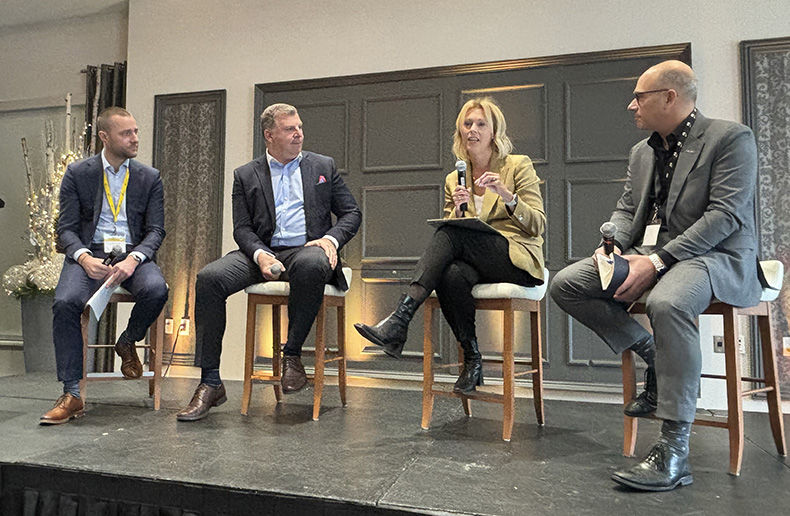Improving customer experience has become essential for companies striving to digitize their interactions with consumers. According to three industry experts, insurers can benefit from emulating the best practices from both the financial services sector and other industries.
Representatives from three major financial institutions active in the insurance market recently shared their strategies for managing customer relationships. The discussion, moderated by Jimmy James-Bergeron, Leader, Customer Transformation, Financial Services at EY, took place at the EY Insurance Rendezvous in Quebec, held in late November in Quebec City.
iA: A federative approach to customer experience
At iA Financial Group, the customer experience (CX) function has been centralized but in a federative manner, explains Vincenzo Ciampi, Senior Vice-President, Global Client Experience (GX).
This unit serves as a central hub collaborating with other business units. "It's not purely centralized; it's a mix of both. This has brought us some significant gains," says Ciampi.
The company’s board of directors and senior leadership extensively discussed the creation of the GX function, Ciampi recalls. The organization had recently experienced significant growth through both organic expansion and acquisitions, leading to a rapidly growing client base. Diverse teams across the company had been working independently on customer experience initiatives.
"The idea was to bring together these disparate functions, unify them, and then work with business lines across Canada and the United States," adds Ciampi.
Desjardins: Customer experience as a discipline
At Desjardins, customer experience became a formal discipline in 2012, says Sophie Bergeron, Senior Director of Member and Client Experience. "The way we aligned strategy, culture, purpose, and most importantly execution, started with the implementation of the Net Promoter Score (NPS) system," she says.
The NPS system is supported by five key pillars: sustained organizational leadership, robust data and analytics foundations, reliable indicators, continuous improvement loops based on member and client feedback, and, finally, happy employees, Bergeron explains.
Employee experience is a critical component. Internal surveys are conducted to assess the consistency of the organization's approach to customer service. "We want to hear from employees about whether we’re truly walking the talk. If we claim that member and client interests are at the heart of our actions, are we really delivering on that? It’s our North Star," she says.
Customer experience is embedded in Desjardins’ strategic planning, with a significant budget allocated to executing plans across various business sectors. "We’ve tried different models in the past. Now, we have a central team that supports all business sectors and support functions," Bergeron adds.
The team handles data and analytics, designs customer experiences, and assists business lines in implementing their operational plans.
Beneva: Leveraging martech for customer data
At Beneva, Louis-Philippe Roux, Vice-President, Marketing and Commercialization, emphasizes the use of marketing technologies (martech) to harness data from various business units. Beneva operates across all sectors of the insurance industry: property and casualty, group, individual, and financial services.
"We collect a significant amount of data internally as well as externally. All this data needs to be effectively utilized," says Roux. Without an integrated data management system, maximizing the company’s impact on its clientele is impossible.
The proliferation of media channels compels the company to manage its marketing investments carefully. "How do we select the best way to reach our customers in today’s fragmented media landscape? We have connected TVs, traditional TV, digital advertising, outdoor advertising, and everything people do online," Roux explains.
In property and casualty insurance, where Beneva maintains a strong presence through its direct distribution network, the number of customer interactions is higher compared to individual insurance. In the latter segment, customer experience often occurs during estate settlements, many years after the product is purchased, Roux notes.

From left to right: Jimmy James-Bergeron, Vincenzo Ciampi, Sophie Bergeron and Louis-Philippe Roux.
Executive commitment and measuring impact
According to Ciampi, the GX team at iA Financial Group operates as a distinct business unit with performance metrics for sales, profits, and other key indicators. "We have a seat at the decision-making table," he says.
Customer-centricity must be a top priority for the company’s senior leadership. "If it’s not among the CEO’s top five priorities, even the best team won’t have the same impact," Ciampi adds.
Fortunately, Ciampi believes his company fully embraces this mindset.
Learning from challenges: The impact of hurricane Debby
Both Desjardins and Beneva faced significant challenges in August 2024 when tropical storm Debby caused severe flooding in southern Quebec.
Bergeron notes that such events can strain member and client loyalty, as evidenced by NPS trends following previous disasters. "We learned from past experiences, listened to what mattered most to them, and really rose to the occasion last summer," she says.
Similarly, Beneva leveraged its client knowledge to orchestrate communications during the floods. Regardless of how customers reached out to the insurer, establishing communication was challenging.
"We used the information we had to personalize communications. Depending on the client’s profile, messages were sent through their preferred channel," Roux explains. By leveraging data on affected clients’ locations, Beneva reassured those concerned about delays in claims processing or indemnity payments.
This experience highlights the importance of martech systems in meeting client expectations proactively. "We managed to navigate the unpleasant situation while preserving customer loyalty," adds Roux.
Technology, personalization, and agility
The rising cost of property and casualty insurance premiums has been a pain point for consumers. Martech tools also help mitigate the shock of price increases at policy renewal. "We can’t control everything, and some clients remain dissatisfied, but preventive communication helps us limit churn," says Roux.
Ciampi stresses the importance of measuring customer sentiment through various indicators. "Without metrics, you’re speculating and relying on assumptions," he says, adding that his team is obsessed with measurement.
Even when the company is performing well, with strong stock performance and satisfied shareholders, complacency is not an option. "You must continually reinvent yourself," he adds.
Ciampi believes companies should benchmark themselves against the best—not just other financial services firms. "Banks do great work in customer experience, but are they truly the best? Absolutely not."
He points to Amazon, Tesla, and Disney as examples to follow. "Even if your customers are satisfied today, never assume they’ll stay. Agility and speed of execution are crucial," he insists.
AI and the future of Customer Experience
Bergeron envisions artificial intelligence (AI) as a driver of increasingly personalized customer experiences. At Desjardins, virtual clients, or synthetic respondents, are used to test products and services, improving their features. "We evaluate factors such as response times, interaction quality, and claims management," she explains.
Desjardins sees itself not just as a financial institution but as a partner supporting its members and clients in achieving financial independence. "This opens up new possibilities for understanding and meeting customer expectations," Bergeron says.
For Roux, employee buy-in is essential for adopting new technologies and enhancing customer interactions. "It must be a collective effort across the organization," he says.
Client consent is the cornerstone of personalized communication, Roux emphasizes, particularly as legislation tightens around data privacy, as seen with Alphabet’s handling of cookies on Google. "Whatever system you implement to improve customer experience, it must comply with the rules," he says.
While martech tools are integral to Beneva’s IT infrastructure, Roux cautions against relying solely on vendors’ promises. "Some providers overpromise, but the system must align with the company’s vision. At Beneva, we’re here to support clients throughout their lives, especially with what matters most to them, in a simple and straightforward way," he says.
"In insurance, the goal is to make the experience as seamless, simple, and painless as possible. The customer should decide how they want to communicate," Roux says.




